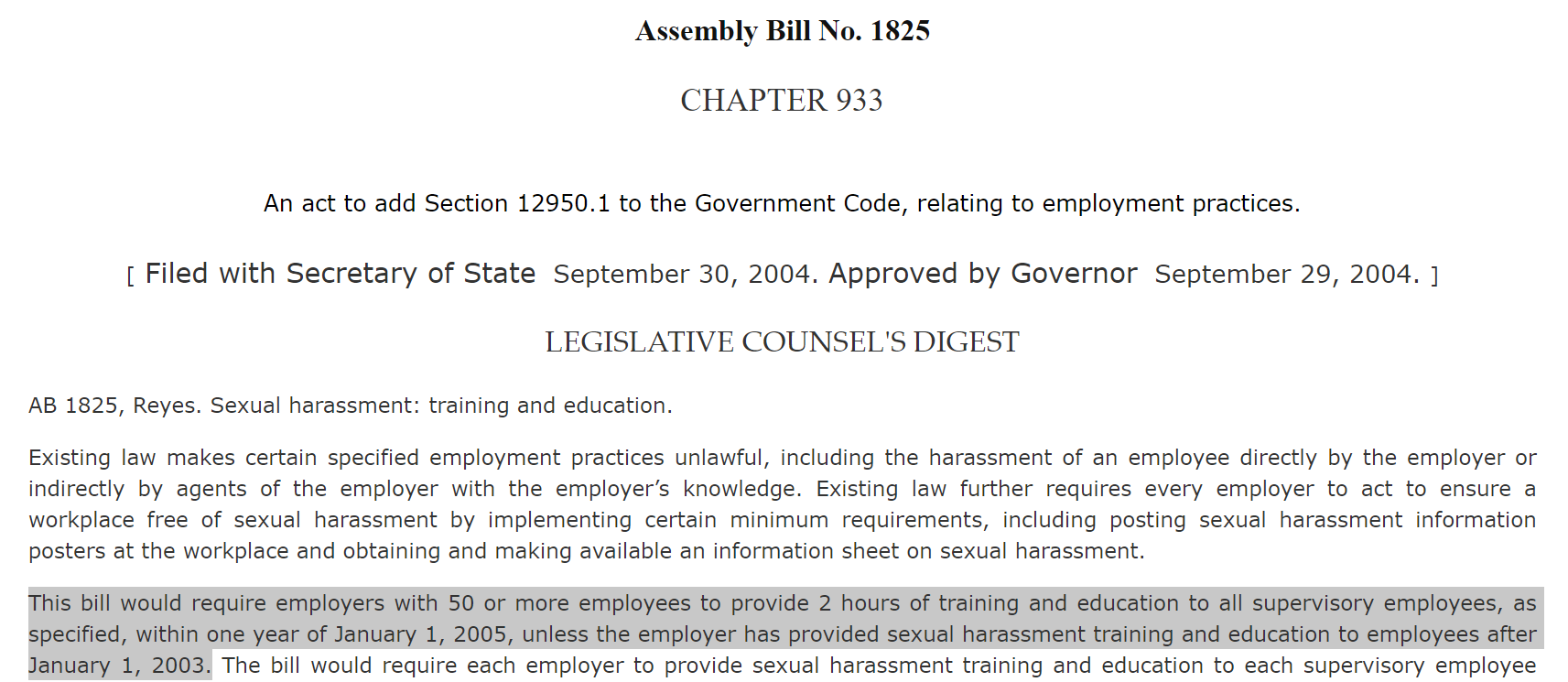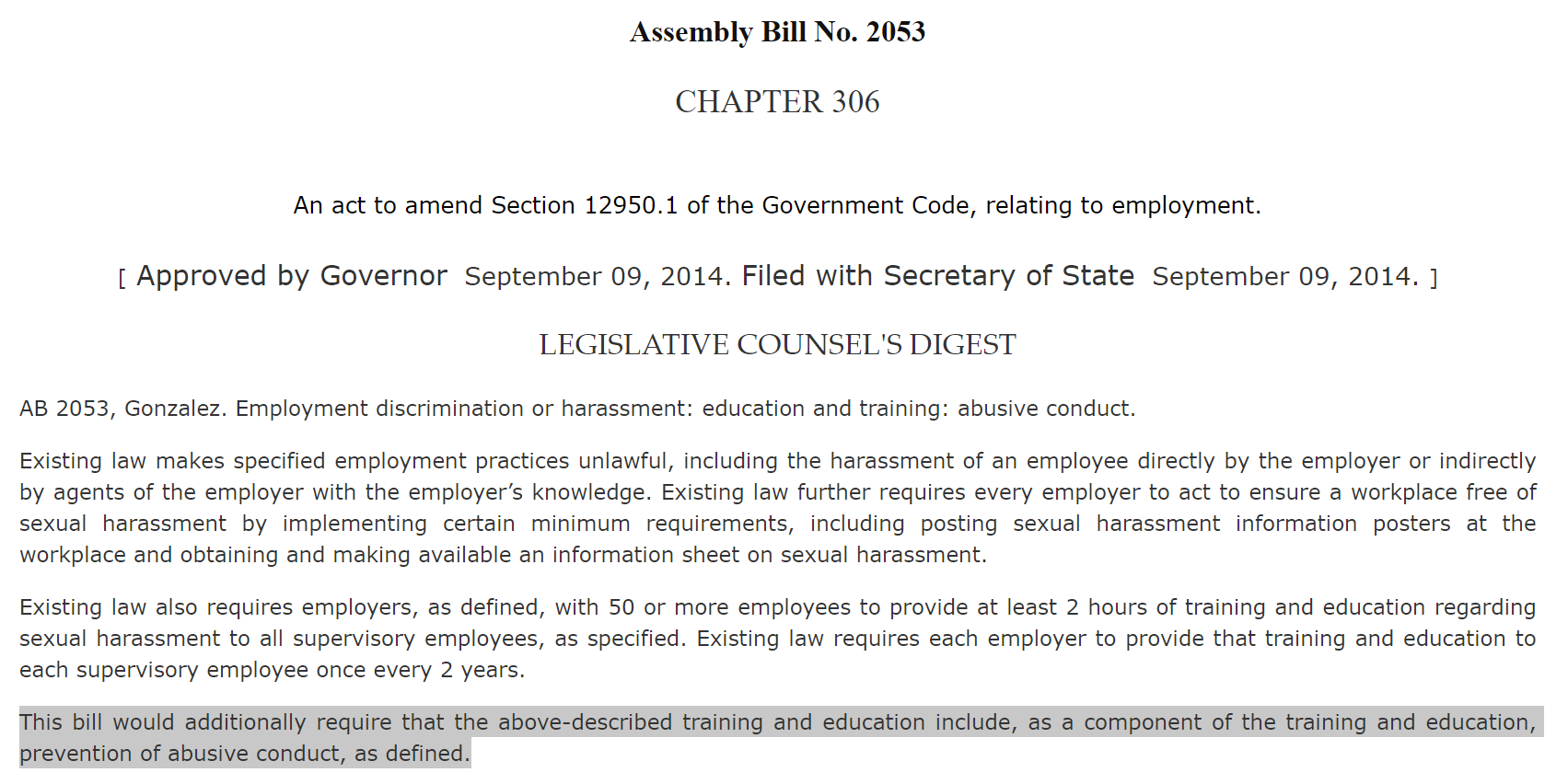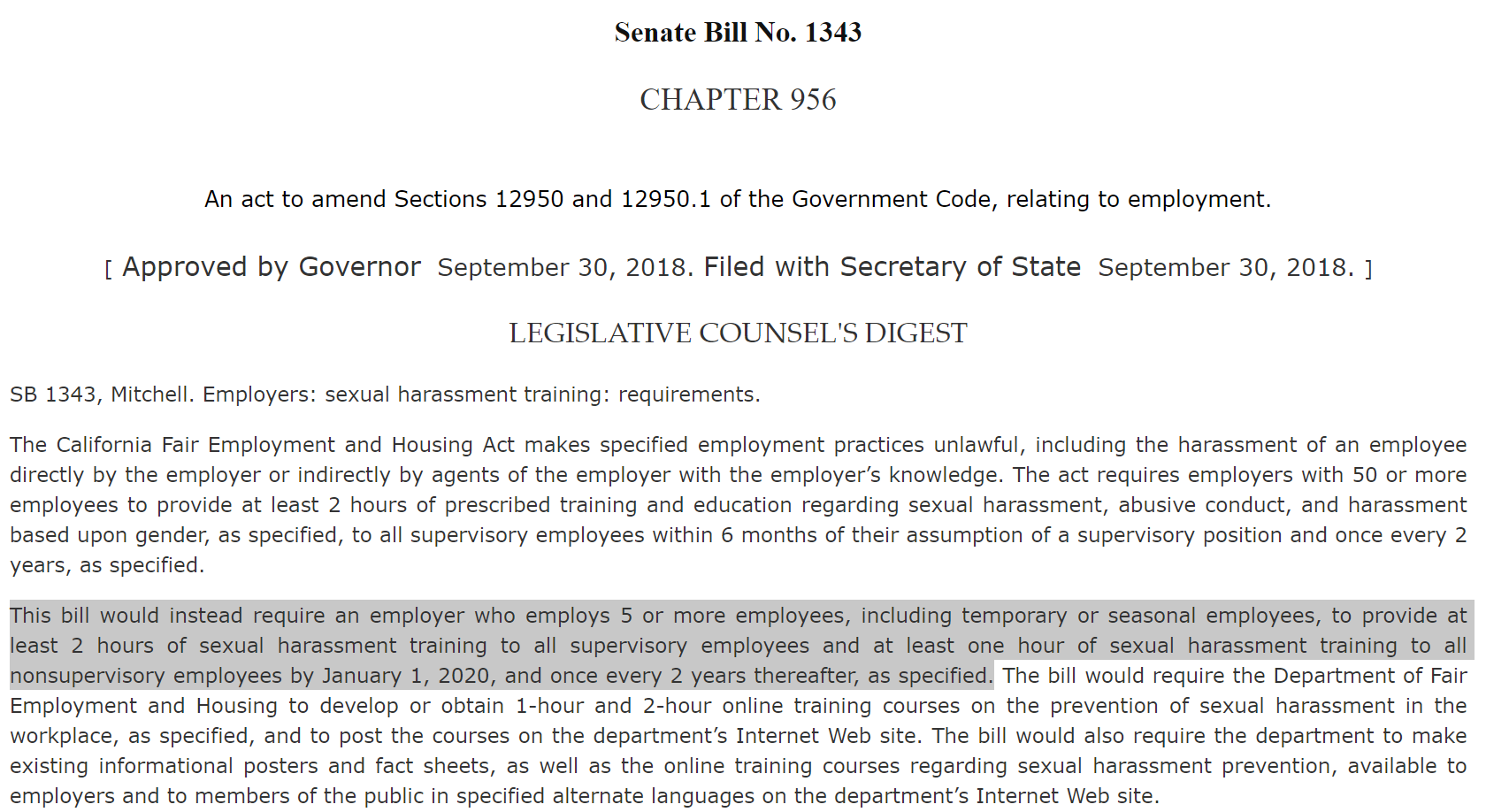The Complete List of Sexual Harassment Training Requirements for California
What good is training if it doesn’t meet state-level mandates? Here is the complete list of sexual harassment training requirements for California.

50% of all workplace complaints relate to sexual harassment.
It doesn’t matter if you’re new to the corporate world or a tenured professional, that’s a disheartening statistic. Even so, it’s generalized.
If you look at the trends on a state level, things look even worse.
In the state of California alone, sexual harassment incidents are 5% higher among men and 10% higher among women in comparison to national averages.
In other words, the state that brought forth and led the #MeToo movement is still running rampant with toxic work environments. It’s a discouraging, ironic reality.
I’m not trying to insinuate that working at or owning an organization in California guarantees that sexual harassment exists there. Instead, I’m leading up to the entire point of this blog post.
You see, California requires that organizations train employees on sexual harassment. Legislatures from the Golden State recognized the bleak reality for many sexual harassment victims and acted on it.
That’s great news, especially considering the statistics I gave you earlier.
Although a step in the right direction, many employers aren’t exactly sure what topics they need to include. That’s an important piece of the puzzle.
After all, what good is training if it doesn’t meet state-level mandates?
Here is the complete list of sexual harassment training requirements for California.
California Sexual Harassment Training Timeline
Before listing all of the requirements for you, you must understand the precedent.
You see, sexual harassment training as a requirement isn’t a new concept. It’s been a requirement for almost 20 years.
AB 1825
On September 30, 2004, California passed Assembly Bill (AB) 1825.
AB 1825 mandated that places with 50 or more employees have their team take sexual harassment prevention training.
Organizations needed to provide 2 hours of training to all supervisory employees every 2 years.
It also mandated specific talking points that the content needed. Since many of those are still in effect today, I’ll give them to you in a future section of this blog post.

AB 2053
Naturally, as AB 1825 aged, California’s legislature proposed and accepted changes to what already existed.
Amendments to the sexual harassment training requirements didn’t happen until a decade later with AB 2053 in 2014.
Although this Assembly Bill only made changes to Section 12950.1, it was still significant.
You see, AB 2053 mandated that all California sexual harassment training include a section on abusive conduct. You might be wondering what that is exactly, AB 2053 helped define that too.
Abusive conduct is workplace conduct, with malice, that a reasonable person would find hostile, offensive and unrelated to an employer’s legitimate business interests.

It includes…
- Verbal abuse
- Derogatory remarks
- Threatening verbal or physical conduct
- Intimidation
- Humiliation
- Gratuitous sabotage that undermines an individual’s ability to work
To put it more simply, it’s more commonly known as bullying.
You see, investigators involved with the #MeToo movement came to interesting conclusions. Both the Hollywood magnate, Harvey Weinstein, and Fox News’ CEO, Roger Ailes, determined that they were bullies in the workplace. However, other managers within their organization viewed them as indispensable. Thus, their coworkers mischaracterized their abusive behavior as “personality conflict”.
Harvey Weinstein wasn’t accused until four years after the proposal of AB 2053. Yet, I included his coworker’s mischaracterization purposefully. It helped me explain the relationship between sexual harassment and abusive conduct.
They usually go hand-in-hand, hence why AB 2053 sought to include a section about bullying.
FEHA Updates in 2016
In 2016, state legislatures made adjustments to California’s Fair Employment and Housing Act (FEHA).
The adjustments brought forth a variety of changes. Most of them related to anti-discrimination, harassment and retaliation policies.
However, it also included amendments related to sexual harassment training (duh, why would I include it as a section to this blog post if it didn’t).
More specifically, the training must...
- Have interactive components to ensure that participants remain engaged
- Include substance on potential exposure and liability for employers and individuals
- Include supervisors’ obligation to report sexual harassment, discrimination, and retaliation when they become aware
- Include steps for appropriate remedial measures to correct harassing behavior
- Include and review the definition of “abusive conduct”
- Maintain a record of participants for a minimum of two years
SB 396
Just three years after AB 2035 came California Senate Bill (SB) 396 in 2017.
One of the main reasons why this bill likely came was as a direct result of the Supreme Court legalizing same-sex marriage in 2015.
Another reason for SB 396 has to do with the fact that almost a quarter of all hate crimes in California had to do with sexual orientation bias in 2015.
In a nutshell, SB 396 added the requirement for sexual harassment training in California to include content on…
- Gender identity
- Gender expression
- Sexual orientation
It also mandated that employers display a poster developed by the California Department of Fair Employment and Housing (DFEH) regarding transgender rights.

SB 1343
The latest adjustment to California’s sexual harassment training requirements came just a few years ago in 2018 with SB 1343.
SB 1343 adjusted the time and organizational requirements for sexual harassment training. Although that sounds like a small adjustment, it was a massive change.
You see, practically every organization had to provide its employees with sexual harassment training with the introduction of SB 1343. More specifically, it went from requiring employers with 50 or more workforce members to 5 or more.
From a time perspective, it kept the 2-hour supervisor training requirement. But, it added that all non-supervisors receive at least 1-hour of sexual harassment training every two years as well.
SB 1343 also imposed requirements on seasonal and temporary employees. These workforce members need to receive one hour of training within 30 calendar days or 100 working hours if they work less than six months.
SB 1343 went into effect on January 1, 2020.

The List of Present-Day Requirements
When you first started reading this blog, you probably didn’t realize what you were getting yourself into.
You see, it’s without a doubt that sexual harassment training is a requirement for organizations in the state of California.
However, it gets much more complicated once you start diving into the requirements related to…
- Time
- Organizational roles
- Content
That’s why we had to go over the timeline before diving into the present-day requirements.
Anyway, now that we got through it, it’s time to list all of the sexual harassment training requirements for California.
- The legal definition of sexual harassment provided by both California FEHA and Title VII of the Civil Rights Act of 1964
- Provide guidance regarding laws and state statutory provisions concerning the prohibition of sexual harassment, discrimination, and retaliation
- Include examples that instruct employees on abusive conduct that's considered harassment
- Include content on gender identity, gender expression and sexual orientation
- Workforce supervisors’ obligations to report abusive conduct and discrimination at work
- A description of the reporting process to serve as remedies available to workforce victims of sexual harassment
- Information and guidance on what supervisors should do if they’re accused.
- Providing sexual harassment training to supervisors and non-supervisory every 2 years
- Training must last 2 hours for supervisors and 1-hour for non-supervisors
- Training must include interactive components to ensure participants remain engaged and retain the material
- Organizations must maintain a record of participants for a minimum of 2 years
- Discussion of strategies that constitute an effective anti-sexual harassment policy
- Display of California’s DFEH transgender rights poster in a visible area
Conclusion
The statistics that I provided in the introduction of this blog post painted a grim picture for California. But, the state remains at the forefront of battling sexual harassment.
There’s was a lot of success from the #MeToo movement that originated in the state. Since then, many states now require organizations to sit through sexual harassment training.
You see, California has had sexual harassment training as a requirement since 2004. Since then, the state continues to make adjustments to what’s required. In other words, the state isn’t planning on giving up the fight on sexual harassment in the workplace anytime soon.
So, if you’re an organization that’s headquartered in California, you have some obligations to hold. You need to make sure that your sexual harassment training meets every requirement listed within this blog post.
Emphasize your product's unique features or benefits to differentiate it from competitors
In nec dictum adipiscing pharetra enim etiam scelerisque dolor purus ipsum egestas cursus vulputate arcu egestas ut eu sed mollis consectetur mattis pharetra curabitur et maecenas in mattis fames consectetur ipsum quis risus mauris aliquam ornare nisl purus at ipsum nulla accumsan consectetur vestibulum suspendisse aliquam condimentum scelerisque lacinia pellentesque vestibulum condimentum turpis ligula pharetra dictum sapien facilisis sapien at sagittis et cursus congue.
- Pharetra curabitur et maecenas in mattis fames consectetur ipsum quis risus.
- Justo urna nisi auctor consequat consectetur dolor lectus blandit.
- Eget egestas volutpat lacinia vestibulum vitae mattis hendrerit.
- Ornare elit odio tellus orci bibendum dictum id sem congue enim amet diam.
Incorporate statistics or specific numbers to highlight the effectiveness or popularity of your offering
Convallis pellentesque ullamcorper sapien sed tristique fermentum proin amet quam tincidunt feugiat vitae neque quisque odio ut pellentesque ac mauris eget lectus. Pretium arcu turpis lacus sapien sit at eu sapien duis magna nunc nibh nam non ut nibh ultrices ultrices elementum egestas enim nisl sed cursus pellentesque sit dignissim enim euismod sit et convallis sed pelis viverra quam at nisl sit pharetra enim nisl nec vestibulum posuere in volutpat sed blandit neque risus.

Use time-sensitive language to encourage immediate action, such as "Limited Time Offer
Feugiat vitae neque quisque odio ut pellentesque ac mauris eget lectus. Pretium arcu turpis lacus sapien sit at eu sapien duis magna nunc nibh nam non ut nibh ultrices ultrices elementum egestas enim nisl sed cursus pellentesque sit dignissim enim euismod sit et convallis sed pelis viverra quam at nisl sit pharetra enim nisl nec vestibulum posuere in volutpat sed blandit neque risus.
- Pharetra curabitur et maecenas in mattis fames consectetur ipsum quis risus.
- Justo urna nisi auctor consequat consectetur dolor lectus blandit.
- Eget egestas volutpat lacinia vestibulum vitae mattis hendrerit.
- Ornare elit odio tellus orci bibendum dictum id sem congue enim amet diam.
Address customer pain points directly by showing how your product solves their problems
Feugiat vitae neque quisque odio ut pellentesque ac mauris eget lectus. Pretium arcu turpis lacus sapien sit at eu sapien duis magna nunc nibh nam non ut nibh ultrices ultrices elementum egestas enim nisl sed cursus pellentesque sit dignissim enim euismod sit et convallis sed pelis viverra quam at nisl sit pharetra enim nisl nec vestibulum posuere in volutpat sed blandit neque risus.
Vel etiam vel amet aenean eget in habitasse nunc duis tellus sem turpis risus aliquam ac volutpat tellus eu faucibus ullamcorper.
Tailor titles to your ideal customer segment using phrases like "Designed for Busy Professionals
Sed pretium id nibh id sit felis vitae volutpat volutpat adipiscing at sodales neque lectus mi phasellus commodo at elit suspendisse ornare faucibus lectus purus viverra in nec aliquet commodo et sed sed nisi tempor mi pellentesque arcu viverra pretium duis enim vulputate dignissim etiam ultrices vitae neque urna proin nibh diam turpis augue lacus.




